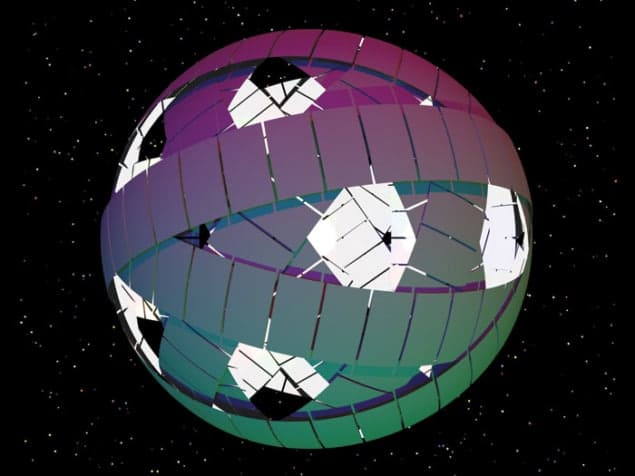Philip Anderson reviews Maverick Genius: the Pioneering Odyssey of Freeman Dyson by Phillip Schewe

The “maverick genius” referred to in the title of Phillip Schewe’s book is Freeman Dyson: a truly great mathematical physicist, bestselling author, longest-serving member of the US military’s JASON advisory group, and occupant of the “fourth chair” when the Nobel Prize for Physics was awarded for quantum electrodynamics (QED) – among many other distinctions. Indeed, a biography of Dyson was long overdue, even though his own autobiographical writings are extensive and so beautifully written that no ordinary author could match them, Schewe included.
Why, in that case, should we bother with this biography? Because, as the author makes clear, there are many Freeman Dysons, and how they developed (evolved?) into each other, and what their relationship is, are both relevant parts of his story – as is some kind of appraisal of what one is to make of the final individual.
My own contacts with Dyson have been indirect. Of course, I tried to understand the fundamental QED papers of 1949 that revised all our views of quantum field theory, and I used the techniques presented in them to help solve a puzzle in solid-state physics. Then, in 1958 I was chosen as a substitute for Dyson after he was enticed away from the University of California, Berkeley – where he had spent three summers researching condensed-matter problems with Charles Kittel – to work at General Atomics in La Jolla, California. There, for much more money than Kittel could command, Dyson helped design the safe reactor TRIGA and the Orion spaceship. (I had a marvellous summer at Berkeley, though my papers were crude compared with Dyson’s.) But we did not meet until the first energy crisis, when we both attended a workshop on energy that was sponsored by the American Physical Society. Afterwards, we met at disarmament seminars at Princeton University in New Jersey, which is where I first sensed his ambiguity about conventional liberal positions on subjects such as the “Star Wars” defence initiative – most of which I hold unambiguously.
This is not an authorized biography, so Schewe did not have access to any private letters in his research. However, he is a well-known popularizer of physics (being employed in that capacity by the American Institute of Physics) and he has done a meticulous job of finding all of the relevant sources available. He has researched the course of Dyson’s life in detail, beginning with his privileged and precocious childhood at Winchester and foreshortened Cambridge years, which were overshadowed by the approach of the Second World War. Dyson spent the war years doing operations research for Bomber Command, and his determinedly itinerant graduate years with Hans Bethe and Richard Feynman culminated in the great breakthrough of QED. After his relatively brief, but scientifically fertile, junior faculty years at Birmingham and Cornell, he settled permanently at the Institute for Advanced Study (IAS) at Princeton in 1953, at the age of 30.
“Settled”, however, is hardly the word for it: the liberal vacations and relaxed leave policies of the IAS have enabled Dyson to become the epitome of the “have briefcase, will travel” scientist, bringing him several further careers. The one that seemed to leave the strongest impression on him was his involvement with the nuclear world and particularly the Orion project, which foreshadowed major themes of his later career. Orion was a nuclear-powered spaceship that he, Edward Teller and Ted Taylor designed in 1959 and advocated thereafter, and this experience seems to have left him with a visionary predilection for thinking the unthinkable in terms of the long-term future of the human (or other intelligent) race in space. He also became a major influence in the effort to achieve some measure of nuclear disarmament; after initially opposing the test ban treaty, as a JASON consultant he co-wrote an influential report opposing the employment of nuclear weapons in Vietnam.
Until the 1980s Dyson kept up a continuous and active career in mathematical physics, with occasional forays into broader interests such as condensed matter, biology (particularly studies on the origins of life) and astronomy. Around that time, he discovered his second métier as a writer of extraordinarily readable prose. A number of well-received essays were followed by his first autobiographical book, Disturbing the Universe (1979), which was nominated for the US National Book Award. Then came Weapons and Hope (1984), which captured the public’s interest in the Reagan administration’s Strategic Defense Initiative (the aforementioned “Star Wars”). He continues to publish a book every few years as well as many articles and book reviews. Partly thanks to his prolific writing, but also because he seems to have something inspiring and beautifully phrased to say for any occasion, he has become a popular lecturer and maintains a frighteningly full travel schedule. Most recently he has delighted in maintaining minority views on a number of topics such as climate, religion (his Christianity places him in the minority for his profession) and genetic modification.
Did he ever have time for a private life? Schewe’s book records Dyson’s claim (perhaps a dubious one) to have had two principles in his relations with women: he did not allow himself to become interested if he didn’t have marriage in mind; and he intended to have six children. He proposed to his first wife, Verena – a bright, glamorous mathematician and single mother at the IAS – almost on meeting her, and wooed her by mail for over a year throughout his continual travels until (with some reluctance on her part) they married in 1950. She bore him two children before a miscarriage, but theirs was a somewhat stormy marriage, noteworthy for the fact that her thesis and mathematical notes were deliberately burned in the interest of domesticity. Both children, Esther and George, became well-known figures, she as a journalist-entrepreneur and he as an author. Dyson’s second wife Imme, formerly his children’s au pair, produced four more daughters. Friends of his children report that Dyson is a kindly, avuncular figure, though a rather strict father.
A more important question, though, is whether Dyson is the important world figure that Schewe makes him out to be. In his career, we can see traces of the mathematical physicist’s reluctance to tackle the ambiguous or deeply puzzling question, or to go out mathematically even a little bit on a limb – something that contrasts sharply with his joyful interest in bizarre futurology. Perhaps this is the source of Dyson’s dreadful misjudgment on the climate question: he sees that the possible errors are large, but does not factor in that they are likely to be large in the wrong direction, and does not credit obvious qualitative arguments from simple laws of physics.
One could wish, as in many biographies of scientists, that the scientific contributions were more critically presented and contextualized. Sometimes the hype goes too far, as when Schewe compares Dyson’s popularity as the guru of QED in the 1950s with the Beatles’ “conquest of America” in the 1960s. Dyson’s very elegant arguments do not always have much to say about how things work in the real world, and the author makes little effort to distinguish whether they do. He did not, for one thing, participate in any of the revolutionary events that created the Standard Model. However, my own preference is for the sloppy and practical rather than elegant and precise, so I am prejudiced.
It is natural for biographers to fall a little in love with their subjects, but on balance, this book leaves the reader intrigued but a bit unsatisfied. Dyson is a superbly able man and has done so much, but what if he had focused on one career? Perhaps the career he really wanted was scotched, as Schewe suggests, by the fallout problems of Orion? In any case, he is worth reading about and marvelling at.
- 2013 Thomas Dunne Books £17.49/$27.99hb 352pp



